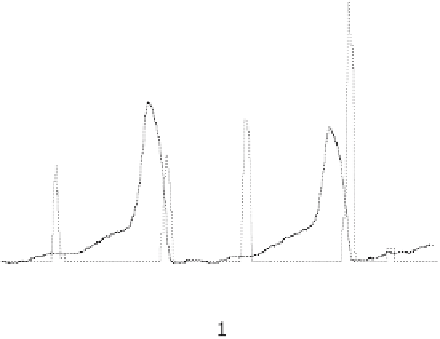Biomedical Engineering Reference
In-Depth Information
4500
K
P
D
(ventral)
(pressure)
(dorsal)
syllable
syllable
0
T(s)
Fig. 5.9.
The pressure and the smoothed-rectified activities of the dS and vS
muscles during the production by cardinals of a pair of syllables. Adapted from
Fig. 5.4 in [Mindlin et al. 2003]
The EMG data were sampled at 40 000 points per second. In order to
reconstruct a measure of the muscle activity, the signals were rectified and
smoothed. Rectification is needed in order to eliminate the artificial bipha-
sic nature of the recordings, a result of the bipolar nature of the electrodes.
The smoothing consisted of replacing each point by the average of its neigh-
bors within a 0.2 sec window. In Fig. 5.9, we show the processed data. The
vocalizations are produced basically when the air sac pressure is positive.
Notice that the activity of the vS muscle increases towards the end of the
vocalization. Therefore, according to the model, we expect the syllables being
produced to be
upsweeps
.
The relationship between an EMG signal and the tension that is gener-
ated in the muscle is likely to be a complex one. Even from experiment to
experiment, it is reasonable to expect important variations owing, for exam-
ple, to the different contact areas between tissue and wire. For this reason,
an absolute calibration is not possible. However, for the qualitative test that
we have described, a monotonically increasing function relating the EMG to
the tension is enough.
The actual test consisted of two parts. First, linear relationships were
assumed between the envelopes of vS activity, dS activity and pressure (mea-
sured in Volts), and the functions
k
,
f
0
b
, respectively, in (5.10).
This procedure had to be repeated for each experiment. Then, these “exper-
imental” instructions had to be used as driving functions in the model. The
final step required the comparison between the syllable synthetized using the
experimentally driven model, and the actual song. It is important to require
in this test that within an experimental session, the same values of the fitting
parameters used to map the EMG data to the driving functions (which were
and
β
−






































